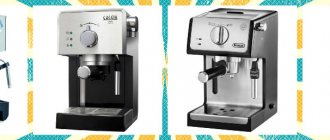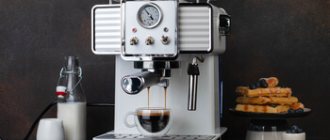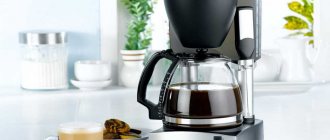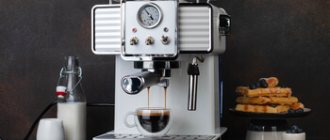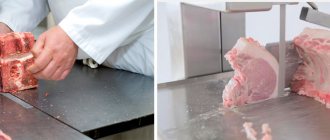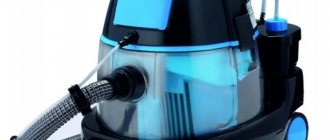There are many types of coffee brewing machines. They can be electric or not require electricity to operate. Depending on the degree of automation, there are automatic, semi-automatic and super-automatic.
Manual coffee makers, that is, coffee makers without heating elements, after filling with ground coffee and water, require installation on the stove.
A coffee machine or coffee maker is a device designed for brewing coffee.
The following types of coffee makers exist:
Drip (Americano, filter) coffee maker
The device, invented at the beginning of the 19th century by a church minister, has still changed little in design and principle of operation.
An electrical device using a filtration method and a percolation process consists of two vessels: for water and for the finished drink. However, in the low-price segment there may be no vessel for collecting the finished coffee drink.
The heated water in the vessel rises through a vertical tube. Further, percolating through the filter with ground coffee, it picks up aromatic substances from there. Then it goes into the compartment for the finished drink, located under the filter.
Drip coffee makers can only make strong or mild Americano or, in other words, filter coffee.
The strength of the coffee produced in such a device depends on the degree of grinding of the beans and its type. Coarsely ground coffee powder in such a machine produces unsaturated coffee, while finely ground coffee produces bitter coffee.
People who love coffee that is not dangerous to health, not strong, with low caffeine content and in large quantities.
Simple and inexpensive drip coffee makers are purchased both for home kitchens and for professional purposes in small coffee establishments. Drip coffee makers are popular in the Nordic countries and the USA.
Drip coffee makers are equipment made of heat-resistant glass, a thermos, or a body made of plastic or stainless steel. For home cooking they produce volumes from 1-2.5 liters, for catering establishments or coffee shops from 5 to 40 liters.
Modern drip coffee makers were achieved through the modernization of percolators.
Percolators were produced in large volumes for use in catering establishments and cafes. Equipment with a volume of up to 15 liters were universal, cheaper and simpler than drip devices. The drink in percolators turned out bitter due to direct contact of the water with boiling water at 100°C. At this temperature, essential oils and caffeine in coffee are destroyed. Therefore, there was a need to obtain other equipment in the form of drip coffee makers.
Coffee makers operating without an electrical connection:
Cezva (Turkish)
A turk or cezve (from the Turkish Cezve) is a cone-shaped, thick-walled container, the bottom of which is widened downward. This coffee maker has a very narrow neck, which is designed to retard the evaporation of coffee aromatic compounds. Turks are equipped with a long handle made of non-thermal conductive materials. The cezve is made of ceramics, stainless steel and other metals such as aluminum, copper, brass. Turks or cezves are made with a volume of 1 to 10 cups. The number of servings or volume is indicated on the bottom of the vessel. In a Turk, very finely ground coffee is used to prepare Turkish or Arabic coffee. When preparing, ground coffee beans, spices and sugar are poured into the cezve, filled with the required amount of water and boiled on a stove or on a special tray with sand, without bringing it to a boil.
Criterias of choice
A coffee machine is a device that is purchased for a long time, so choose which one you want in advance, with the functionality that is preferable to you. It is not difficult to make the right choice if you know what the device consists of and what functions it has.
Millstone
These are the elements responsible for grinding coffee beans; they can be made of steel or ceramic:
- Steel ones are considered reliable; it is safe for them to get into the raw materials from third-party small objects, like pebbles. Disadvantage - they can burn out the grind due to heating, which will certainly affect the taste of the drink.
- Ceramic. They do not heat up, which means they do not burn out raw materials, and they operate more quietly. The disadvantage is fragility, they can break if hit by the same pebbles.
Fine grinding of beans is used in making espresso; here you need fast brewing and sufficient strength. The large one is used in making Americano.
Control type
Coffee machines can be controlled in two main ways:
- Mechanical . The instrument has one or more control switches.
- Electronic . The machine has a touch panel and buttons for setting up the program.
The first control is simpler, more reliable, and does not involve program freezes or glitches. The second option benefits from greater functionality, convenience, style and design.
Water heater
The device for heating water here is a boiler or thermoblock:
- After the boiler
- The thermoblock uses only the amount of water needed for brewing and simply stops after heating.
The disadvantages of the boiler are obvious. Water that is constantly heated loses its taste, and this certainly affects the quality of the drink. In addition, plaque will collect faster on the walls of the container. This means you will need to clean it more often. The second option for choosing a heater is more economical; the coffee tastes always natural.
For home use, it is more advisable to choose a thermoblock. Heating is faster for one cup. The boiler type of heater is more suitable for offices where performance, rather than speed, is needed.
Brand
Consumer demand indicates that the brand name plays a significant role in the choice. This is a kind of quality mark and evidence that the coffee machine is reliable and will last a long time. Leading brand companies include:
- Krups;
- Delonghi;
- Jura;
- Gaggia;
- Saeco;
- Bosch.
Power and performance
These two parameters are considered basic, and before choosing a coffee machine for home use, attention is paid to them first. The higher the power settings, the faster the machine will prepare coffee. But at the same time, the taste and strength of the drink will significantly decrease. This is explained by the fact that at high power the water will pass through the grinding too quickly, not having time to absorb the aroma and taste.
Capacity affects the number of people willing to consume the drink. That is, the more family members drink coffee, the more productivity will be required.
The optimal choice for a family: productivity – 30 cups of coffee is enough. Power – 1000-1500 W. For an ordinary family, these indicators are quite enough. It is not recommended to buy higher, as this will cause the taste of the coffee to be lost.
Big or small – size matters
Owners of a large kitchen and a large family can pay attention to large-sized coffee machines. Compact sizes are better suited for an ordinary city kitchen. To choose the right one, you need to know how many people live in the apartment and how often they drink coffee.
According to statistics, for an ordinary family a car with dimensions of 19.5 × 34 × 47.7 (w × d × h in cm) will be sufficient, respectively.
The best is the one that best meets all your requirements and needs. If you choose correctly, it will be a faithful assistant, especially in the mornings, when there is not enough time and you really want to drink coffee.
Brewing mechanism cleaning system
The brewing mechanism is often called the heart of the coffee machine. The quality of the prepared drink, the preservation of the aroma and all the beneficial substances that are in it depend on it. The choice of an automatic coffee maker should also be based on the availability of this option.
Availability of a cappuccino maker
Cappuccino lovers need to pay attention before choosing a machine whether it can prepare it. Not every machine may have a cappuccino maker, but most models have this function. The purpose of this device is to whip milk into foam efficiently. May be:
- Mechanical, where the milk is whipped separately from the coffee container using steam.
- Automatic. The device itself whips up thick foam from the milk and delivers it into the cup.
Functionality
The differences between one model of coffee brewer and another are:
- grinding degrees of coffee beans 3-12;
- temperature of the drink: hot, scalding or warm;
- strength and richness;
- volume of 1 serving;
- number of cups prepared at the same time;
- presence of heating of an empty cup;
- filter, if the water poured into the device is taken from the tap;
- presence or absence of the “Descaling” function;
- second boiler, for the option of accelerating milk frothing;
- internal memory for cases when each family member prefers to drink a certain drink, and not just black coffee.
Steam function
If your machine has this option, the coffee will brew faster. Steam is also used to make foam from milk. Such machines usually have two thermoblocks or a thermoblock-boiler system.
Grinding control options
The presence of such an opportunity as regulation of coffee preparation makes it possible to independently control the process. The best, good models have it. Thanks to it, you will always brew invigorating and aromatic coffee without losing the taste and beneficial qualities of the drink.
Brewing mechanism type
There are two types of brewing mechanism.
Removable
It will need to be removed and cleaned by hand from time to time. Disassemble, wash, dry and reinstall.
Pinned
Installed in automated machines. She herself gives a signal for cleaning. The user will need to load a cleaning tablet by activating the Clean function.
There are no specific recommendations here. The buyer has the right to make his own choice in favor of one type or another. The second one is more convenient, but also costs more.
Coffee powder steeping system
There are machine models that soak the coffee first before preparing it. This allows you to maximize the aromatic and quality properties of the grind. The coffee turns out very rich and tasty.
Cup warming
According to the rules for brewing espresso coffee, the container into which it is poured must be preheated. To avoid doing this procedure manually, when choosing a coffee machine for home use, pay attention to the presence of this option.
Strength dosage
If such an adjustment is available in the machine, then the strength of the drink can be adjusted at your discretion.
The strength of the drink varies between 6-16 g of ground beans per 1 cup. In some models, the strength can be adjusted by the rate of supply of hot liquid with increasing pressure.
Selecting the required volume of water for 1 serving
This parameter is important only in cases where a coffee lover drinks the drink in large portions. Or when you need to prepare more than 1 serving of coffee at one time.
French press
The French press is the simplest of all coffee brewing devices and gives you a basic level of coffee making skill.
They maintain the correct water temperature throughout the entire process, which affects the quality of the coffee. Drip machines and percolators often heat the water quickly and cool it just as quickly, so that the correct temperature is only reached halfway through the process rather than throughout the brewing cycle. Moreover, paper filters in drip machines absorb most of the oils in coffee powder, which give the aroma of coffee. The device uses 60-70 grams of coffee per liter of water.
Features of coffee machines
A coffee machine is a high-power coffee maker, has a significant size, and allows you to prepare drinks according to several recipes.
Almost all coffee machines are designed for automatic operation using whole coffee beans. The unit has high power, significant size, and allows you to prepare drinks according to several recipes.
It consists of several nodes, the description of which is presented below:
- Coffee container.
- Built-in coffee grinder.
- Compartment for filling water.
- Waste container.
- Built-in cappuccino maker.
Functionality
Automatic coffee machines have a wide range of capabilities; their functionality is many times greater than that of coffee makers.
Among them:
- grinding whole coffee beans;
- the ability to vary the strength of coffee;
- you can adjust the water heating temperature;
- the milk is whipped, forming foam;
- preheating coffee cups;
- washing without human intervention.
In this case, human participation is reduced to a minimum. If necessary, the user of the coffee machine can change the degree of grinding of the beans, if necessary, set the desired temperature and create his own cooking recipes.
Advantages and disadvantages of application
Using coffee machines to prepare a drink has many advantages:
- coffee is always prepared from freshly ground beans, which affects the aroma and taste of the drink;
- coffee preparation is carried out quickly and practically without the participation of the consumer;
- cappuccino requires heating the water to more than 100 degrees;
- ease of use of displays on the device body;
- it is possible to select recipes based on personal wishes while saving the appropriate settings.
In case of breakdowns, repair and replacement of parts will be quite expensive.
Such units also have disadvantages. One of the main ones is the very high cost of the device. In addition, coffee machines are large in size, for which you will have to allocate an appropriate area in the kitchen.
Its work is accompanied by noise, since many processes are performed in a compressed time with virtually no pauses between them. Like any kitchen appliance, the coffee machine needs periodic cleaning.
Aeropress
AeroPress is the best alternative to a French press. This is a small, simple, portable device. It will produce a very competitive, frothy cup of coffee, with a quality somewhere between French press coffee and espresso. AeroPress is one of the latest discoveries in the world of coffee. It requires very little space. In fact, the AeroPress looks more like a medical vessel than a kitchen appliance. But that's the beauty of its size. The whole process is marginally more complicated than loading a French press. The cup will be ready faster than using a French press.
Main types of coffee makers
A coffee maker is an automatic or semi-automatic device for preparing coffee by brewing.
Types of coffee makers:
- Geyser (Italian coffee pot);
- Drip (Americano);
- Rozhkovaya (espresso);
- Capsule (container);
- Chaldovaya (for coffee from “bags”).
Alternative brewing methods include a cezve and its electric variety, a French press, as well as all variants of devices for brewing coffee using the pour-over method: pour-over, Chemex, Aeropress and siphon. They stand out in a separate group.
Handpresso
Handpresso (from the English word hand - “hand”) is a miniature model of a coffee maker. It can fit in one person's hand. There is a piston pump inside that creates a pressure of 9 bar. You need to pour ground coffee into the coffee maker when the pressure gauge is at the green mark and add hot water. Then you need to close the filter cover. The finished coffee is poured into the cup at the touch of a button.
Manual portable coffee makers have the advantage of being small in size. You can take them on the road, on any trip. They operate without electricity.
Purover
The English verb pour over gives its name to the method of preparing coffee and the device. The idea was born in Japan from the tea ceremony. The Hario brand from this country produces special kettles for brewing coffee. In addition, pour overs are produced under the KitchenAid brand. And the Bodum company discontinued its pour-over model.
Hario's equipment consists of a special kettle with a narrow, long and curved spout, a pour-over funnel with a filter.
Brewing coffee in a pour over involves pouring water from a kettle with a curved spout onto a filter with coffee powder in a spiral, in a thin stream, moving in a circle, from the perimeter to the center. The finished coffee is collected in a container under the filter. This drink reveals the taste of the coffee bean better. You need to use medium grind coffee powder. The KitchenAid brand pour-over is electric and has a disc installed under the coffee vessel to heat the drink.
Coffee maker with cappuccino maker
A cappuccino maker is a special nozzle attached to a steam wand. To prepare cappuccino, milk and cream are used, which are whipped until foam forms.
- Mechanical (panarello). Coffee makers are equipped with a special bowl into which milk is poured and whipped until foam is formed using a panarello nozzle under the influence of a stream of steam. After this, the foam is poured into a cup with the finished coffee drink;
- Automatic (auto-cappuccino makers). They are divided into two types:
With outlet nozzle.
The coffee maker is equipped with a nozzle extending from the steam wand. The nozzle is lowered into the container and the milk supply is turned on. In this case, coffee and foam are prepared separately. The downside is that it is impossible to prepare cappuccino with one click. It is also impossible to regulate the density of the whipped foam. The advantage of this option is its cost;
With milk container.
The coffee maker is equipped with a glass into which milk is poured. When you press the “cappuccino” button, the program automatically prepares it. Sometimes even the most advanced people are unable to prepare a cappuccino correctly. A small number have fully automated cooking, but are expensive.
Chemex
This method of brewing coffee was invented by an American chemist. A Chemex is a glass container that looks like an hourglass and a pour-over. In fact, it is a flask with a spout on which a glass funnel is installed, which are secured with a leather strap. The disadvantage of the device is its fragility. Hot water and ground coffee come into contact for a short time, resulting in a waterier and less flavorful drink.
Vietnamese Phin Coffee Filter
To brew Vietnamese coffee, use simple Phin. It is called a Vietnamese coffee filter, or coffee press, and comes in sizes ranging from 6, 8, 11 to 15 ounces. This is a simple device for brewing coffee.
It consists of a saucer with a strainer for a glass, a hopper, a press and a lid. The grind should be medium.
Geyser (Italian coffee pot) coffee maker
This type of coffee maker is called an Italian coffee pot, moka coffee maker, steam coffee maker or geyser-type coffee maker. They were patented by Luigi de Ponti in 1933, and mass production was launched by Italian entrepreneur Alfonso Bialetti. Since then, the Bialetti Moka Express has been produced unchanged.
The operating principle is similar to a percolator. Not one, but two containers are the main difference. The installation consists of three sections:
- Lower water tank;
- filter for ground coffee;
- upper container for ready-made coffee.
Coffee makers differ from each other in case material, power, capacity of containers and additional functionality.
The name of the model reflects the principle of operation. The water is heated in the lower container, expanding under increased pressure and entering a funnel-shaped tube. The water then passes through the ground coffee on the filter, extracts the necessary components of the coffee from there, and, like water from a geyser, erupts through a tube into the upper coffee pot.
Geyser-type coffee makers are produced electric (with an internal heating source) and without an internal heating source, which are placed on stoves. In a geyser coffee maker, coffee is prepared in 5 to 10 minutes.
A classic geyser coffee maker has an octagonal bottom vessel. They produce models with a steel or plastic coffee vessel, with a heat-protective handle and a hinged lid. At the foot of the lower vessel in front there is a control panel. The amount of drink depends on the capacity of the device. You can make half a jug or a full jug of coffee.
Coffee brewing occurs in several stages:
- Filtered water is poured into the lower container to a certain level.
- Medium grind coffee is poured into the filter. The powder should be slightly smoothed, there is no need to compact it.
- A filter with ground coffee is installed above the container with water, and a coffee pot is placed on top. Then the coffee maker is either plugged in or placed on the stove. The device turns off manually after a hissing sound appears.
Coffee machines
- Carob coffee makers
- Pod coffee makers
- Capsule coffee machines
Automatic coffee machines
Automatic coffee makers with a built-in coffee grinder are responsible for the entire coffee preparation cycle. They are called espresso makers. The grinding processes, throwing spent coffee tablets into a special container, supplying coffee into cups, everything is controlled independently. Automatic coffee machines are the main type of coffee makers for home (small) and professional (large) use. The price of such devices depends on the power, additional functions and purpose.
Water is poured into automatic coffee machines, the beans are poured into the built-in coffee grinder and the start button is pressed.
At the dawn of the coffee machine, there were huge tower-like devices. And nowadays, home-use devices are so compact that they can fit in any kitchen.
In a coffee machine, all processes and actions are automated and they were originally created for making espresso, using steam under pressure to a filter with ground beans. Modern models can prepare many other types of coffee. Most are equipped with a device - a cappuccino maker for whipping milk foam using hot steam manually or automatically.
Espresso coffee machines
Espresso coffee machines are compression devices. This complex and expensive equipment prepares espresso and drinks based on it. The first espresso coffee machine was patented by Angelo Moriondo, and Luigi Bezzera improved his invention. He added a safety valve, brew groups, milk frother steam tap and removable filter holders to the forerunner of coffee machines. It is thanks to the horns that the devices were dubbed carob coffee machines. They are most often called that in Russia. In the West they mainly call espresso coffee machines.
In the first coffee machines, the pressure of 1.5 atmospheres created when heated in a large boiler forced water and steam through a layer of ground coffee. Achille Gaggia overcame a pressure of 1.5-2 atmospheres. His coffee machine consisted of a plunger cylinder that drove a lever. When you pressed it, 8-10 atmospheric pressure arose in the cylinder. The plunger coffee maker produced an aromatic, rich, strong drink with thick foam.
The 28-30 milliliter volume of an espresso cup was adopted as a standard because the plunger cylinder of the Achille Gaggia espresso coffee maker could hold that amount of water. Steam taps and boiling water taps made it possible to prepare espresso and other drinks.
In 1961, Ernesto Valente created a pump-action coffee maker. The pressure in it was created by an electric pump. Pump machines provide a maximum pressure of 15 atmospheres. The standards of the Italian National Espresso Institute (INEI) state that 9-10 bar of pressure is sufficient to prepare a classic espresso. In a 20-30 second extraction cycle, this pressure is enough to produce an excellent drink.
In espresso coffee makers, the mechanical piston is replaced by a pump, the boiler is replaced by thermal blocks-heat exchangers, which reduce the heating time of water.
According to Italians, the quality of real espresso is determined by the right blend and roasting (Miscela), the right grinding (Macinazione), the right coffee machine (Macchina), and the experienced hand of the barista (Mano).
Semi-automatic coffee machines are in demand by professionals in the HoReCa segment as coffee machines for cafes, bars and restaurants.
How to choose a coffee maker for home use
When buying a coffee maker for your home, you need to compare a number of models according to the following criteria.
- Specializing in a specific drink. If everyone in the family prefers a certain type of coffee, then you need to choose the appropriate equipment for it. For example, a drip-type device cannot brew tasty, strong enough espresso. And vice versa, if strong coffee is not held in high esteem, and Americano is most often brewed, it is not worth paying extra for a capsule-type machine.
- Device power. It determines not only the speed with which the coffee maker will prepare a cup of coffee, but also its efficiency. The more powerful the device, the more electricity it “eats”. It is worth choosing the optimal amount of power: sufficient for your needs, but no more, so as not to be shocked by the electricity bills later. An indicator of 2 kW, even a little less, is enough for home use.
- Water tank volume. This value determines how many servings of a drink the coffee machine can prepare at one time. You need to choose a tank that is enough for one appointment. For example, if only two people in a family drink coffee in the morning, then a 500 ml tank will be enough. Here, too, you need to approach the choice carefully: choose the required capacity, but remember that the larger it is, the more bulky the device itself, and the more energy is spent on its operation.
- Brand. A coffee maker is one case where the manufacturer matters. The leaders in this area are Maxwell, Bialetti, Bosch, Vitek, Delonghi and Nespresso. Coffee makers are now produced by everyone who is not too lazy. Private brands produce coffee makers of average quality, the drink they produce is not the most delicious. And such a device will not last long.
Depending on what your favorite drink is, take a closer look at the devices in this order:
- Carob coffee makers work best with espresso;
- An excellent cappuccino can be brewed by a carob or combination coffee machine;
- for Americano it is better to purchase a drip device;
- those who love variety and choose high quality should take a closer look at capsule devices;
- strong classic coffee will be delicious in a steam coffee maker.
Important: for coffee gourmets who prefer a classic strong drink with a spicy bitterness, a coffee machine with a power of up to 0.8 kW is better suited.
Carob (espresso, holder) coffee maker
This type of coffee maker is called carob or holder espresso coffee makers. Compression devices are automatic and semi-automatic. In semi-automatic machines, some operations are performed by human hands.
They can be used to prepare many types of drinks based on the canonical espresso: cappuccino, latte, Viennese coffee and macchiato. In Italian, the word espresso means “pressed”, that is, coffee prepared under pressure.
Carob coffee makers come in 2 types: boiler (steam, pumpless) with a pressure of 2–4 bar; pump-type (with a pump), creating pressure up to 15 bar. In steam coffee, coffee is prepared in about 3–5 minutes. And in pump-type ones, cooking takes about 30 seconds. The optimal temperature is between 92 and 95 °C.
A device with a pump pump directs hot water or steam under pressure to ground coffee, which is poured onto a mesh filter inside a carob holder. The prepared drink enters the container. Before serving, the cups are preheated so that the coffee does not cool down. In carob coffee makers, aromatic, soft foam (cream) is formed on the surface of the drink.
Types of coffee makers: our conclusion
- Geyser: affordable and quite tasty, but you need to watch the process.
- Drip: inexpensive and reliable, average taste, but a high degree of autonomy - turned it on and went about its business.
- Steam carob: more expensive than drip, but fast.
- Pump-action carob: expensive, but excellent espresso.
- Pod: the same steam carob, only coffee from bags.
- Capsule: expensive connection to the brand, but you won’t have to get your hands dirty.
- What type of coffee makers is your favorite?
Capsule coffee maker (container coffee machines)
The capsules were invented by Eric Favre. Making coffee from capsules was patented in 1978. The idea was born from the development of pod coffee makers. We realized that you can earn more on consumables than on sales of coffee makers themselves. Capsules are aluminum or polymer sealed containers for coffee containing blends, where the degree of roasting, grinding and dosage (7-9 grams) are selected for one serving of espresso.
Capsule coffee machines and capsules for them are produced on the world market by such manufacturers as Nespresso, Dolce Gusto, Cremesso and Tassimo.
These highly automated coffee machines use capsules, where all the coffee ingredients except water are hermetically sealed in capsule form. Capsules with different blends of coffee, with different flavors, cappuccino capsules, with hot chocolate, tea, etc. are sold. There are also capsule coffee machines with a cappuccino maker, where you can diversify your drink recipes.
The device allows a person to prepare a drink simply and quickly, without going deeply into the process and nuances. All he has to do is buy the capsules, press the button, and then simply take care of the cleanliness of the coffee machine.
When choosing a capsule coffee machine, you just need to pay attention to what type of capsules the machine works with. Each manufacturer produces machines under its own brand of capsules. However, there are also devices that allow you to use “non-native” capsules too. Capsules vary in taste, type of drink, espresso, cappuccino, cocoa, tea and so on. Before buying a coffee machine, it is necessary to find out in advance whether it is easy to buy capsules, since some are sold only in special retail outlets.
Pod coffee maker (for coffee bags)
Pods (in Italian “cialda” means “tablet”) were invented by Ernesto Illy in 1974. Pod coffee machines work with coffee bags. A pod is a disposable portion of filter coffee, packaged and pressed in production into a paper coffee tablet. Some companies produce carob steam coffee makers, which combine the ability to use both regular ground coffee and paper coffee bags with a removable filter.
The pod contains 7 grams of a mixture of several varieties of dark roasted Arabica. Pod coffee makers are now used in coffee shops and households to facilitate the process of making coffee. The coffee machine almost nullifies human actions. However, due to the fact that the choice of coffee is made by the pod manufacturer, the user is deprived of the opportunity to experiment with the composition of the coffee mixture. Pods can be bought in specialized boutiques. Since the coffee is packaged and does not come into direct contact with the parts of the coffee maker, cleaning the device is easier.
Thus, the user of a coffee maker with pods definitely benefits from the speed and ease of brewing the drink, but is deprived of the opportunity to experiment with the composition of the coffee mixture - the pod manufacturer decided everything for him.
The main disadvantage of pod coffee machines is the high price of the device and higher costs for a cup of coffee than when brewing it from ground powder or beans.
Lever coffee maker
Lever coffee makers are carob coffee machines. However, they are manual coffee machines. They are chosen by true coffee fans and geeks. The water pressure in lever coffee makers is controlled mechanically using a special lever. The one who prepares the coffee acts as a pump. You won’t be able to buy such a coffee maker in a regular store. Lever coffee makers allow maximum control over the coffee preparation process and require the highest level of work skill from a person.
Coffee maker with timer
The presence of a timer makes it possible to program cooking for a user-specified time or set automatic heating.
The main requirement is the presence of water and grains in the tanks. The rest will be done by the time indicated on the timer.
Not all models have a timer. Most of the devices are in the middle price range and above. Modern coffee makers with a set timer are automatic.
Combined coffee maker models
Combined models of coffee makers are a symbiosis, a combination of several types, namely drip and carob coffee makers. They are very often used in cafes. Installation is carried out in the form of built-in or free-standing devices.
It is very rare to buy such a monster device for home. However, if you still decide to have it at home, then you need to pay attention to the following parameters:
- The power of the machine, which affects the speed and taste of the drink
- Steam pressure
- Operating at temperatures around 95 degrees
- Built-in coffee grinder
- Container volume
- Function for preparing other types of drinks.
pros
- Performance
- Practicality
- Possibility to prepare different types of coffee
Minuses
- High price
- Large dimensions
- Special complex care
Coffee pod makers
This is an expensive device, but it is also fully automatic. All you have to do is place the capsule in the machine and press start. There are two types of capsule machines.
- Devices designed for preparing several types of drinks.
- Machines that can prepare dozens of different types of coffee.
When choosing a capsule machine, it is important to consider whether you are purchasing it for your home or an office machine. The type, volume, and cost of the device will depend on this.
When purchasing a capsule-type coffee maker, it is important to consider the following characteristics:
- By choosing between a plastic or metal model, you choose the lifespan of your machine.
- Not only the speed of operation of the equipment, but also the taste of the resulting product depends on the power declared in the passport. After all, it is known that the less coffee is brewed, the tastier the drink turns out.
- You should not choose models that indicate low pump pressure. This will negatively affect the taste.
- With capsule machines, it is important to consider the noise level produced.
- Coffee maker volume.
Read more: how to choose a capsule coffee maker for your home.
